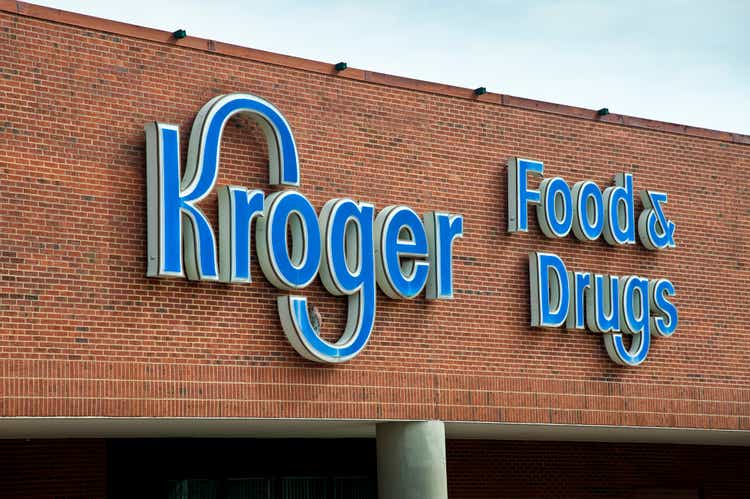Walmart Contender With Stronger Growth: Kroger Plus Albertsons Changes The Game
WendellandCarolyn
NEW YORK (October 14) – The Kroger Co. (NYSE:KR) and Albertsons Companies, Inc. (NYSE:ACI) announced a merger, to be effected by acquisition early this morning. Kroger will pay an estimated total consideration of $34.10 per share, implying a total enterprise value of approximately $24.6 billion, including the assumption of approximately $4.7 billion of Albertsons’ net debt. (The per share value will be reduced by the share value of a subsidiary company that will be spun off. That company will hold up to 375 stores that are, presumably, made redundant by the merger.)
The combined entity will operate a total of 4,996 stores, 66 distribution centers, 52 manufacturing plants, 3,972 pharmacies and 2,015 fuel centers. It will have 13% of the US market share, just behind the 22% of Walmart Inc. (WMT) and employ more than 700,000 people.
Analysis
Exigent need?
As NY Times DealBook analyst Lauren Hirsch pointed out, one of the things that may have motivated Albertsons was the imminent expiration of a lock-up agreement by four of five Albertsons shareholders, who comprise the majority of the shares. The lock-up will expire next week, October 18th, and had already been extended. The potential flood of new shares on the market might have depressed the share value.
A New Retail Behemoth to Challenge Walmart
A Good Deal
With an estimated 13% of the market share and nearly 5,000 locations, the combined retailer will be the third-largest retailer, by sales, in the U.S. and the second-largest “brick-and-mortar” retailer, with $208 billion in U.S. sales. While still less than half the size of Walmart, the consolidated new Kroger entity has a number of advantages and means to outperform the Bentonville giant in the near term following the merger.
- Kroger and Albertsons have the opportunity to realize logistical, purchasing, and pricing efficiencies in a consolidated entity that Walmart’s set-piece organization cannot. If the combined Kroger entity vigorously polices margins in the fashion that Walmart does with its vendors, and focuses heavily on supply-chain and distribution logistics, it will easily produce better margin and profit growth than Walmart will in the near term after the consolidation is affected.
- Kroger and Albertsons are both already mostly unionized so, presumably, have resolved any union issues some time ago. Walmart is, infamously, reportedly hostile to unions and union organizing. The United Food and Commercial Workers International even filed a complaint with the National Labor Relations Board that 2,200 workers had been fired because their stores had been prominently organizing unions. In a tight job market, therefore, Walmart has the risk of unions organizing and driving a hard bargain; risks that are in Kroger’s rearview mirror.
- Kroger friendly relations with unions might also appeal to institutional investors with a high proportion of union pension funds, and particularly those of municipal pension plans in so-called “blue” (i.e., Democrat) cities and states. Pension funds like CalPERS and NYSCRS each bring hundreds of billions of dollars of investment and favor union companies over their non-union competitors in making their investments.
- Kroger, which is entirely in the USA, has the potential in the coming years to expand internationally.
Additional points on the merger are set forth in the investor presentation from this morning.
Kroger is also, significantly, looking to reduce the consolidated entity’s debt burden to no more than 2.5 times EBITDA. That’s 30 bps below the industry and just 40 bps above Walmart, according to GuruFocus, so reasonably competitive. Notably, the debt reduction will occur partially through the cancellation of planned share buybacks that were already announced.
Overall, assuming all goes well with the merger – never a certainty in these things, but far more routine in retail than elsewhere – the combined Kroger entity will have significantly superior value creation, over the medium and longer term, than its Walmart competitor and many others in the retail defensive sector.
Long Kroger for family trusts, college savings plans, young investors’ IRAs, etc. Money will come, but not soon.
____________________________
Note: Our commentaries most often tend to be event-driven. They are mostly written from a public policy, economic, or political/geopolitical perspective. Some are written from a management consulting perspective for companies that we believe to be underperforming and include strategies that we would recommend were the companies our clients. Others discuss new management strategies we believe will fail. This approach lends special value to contrarian investors to uncover potential opportunities in companies that are otherwise in a downturn. (Opinions with respect to such companies here, however, assume the company will not change).


